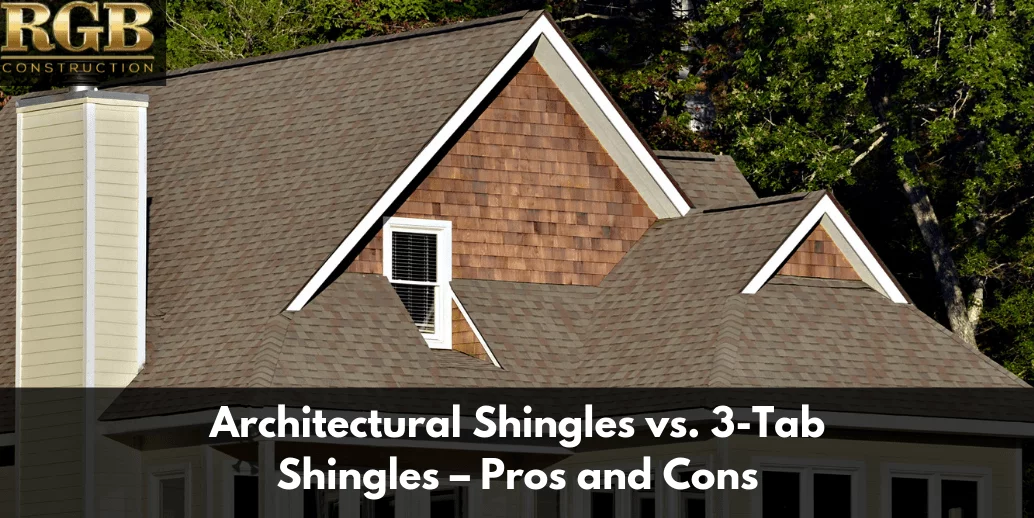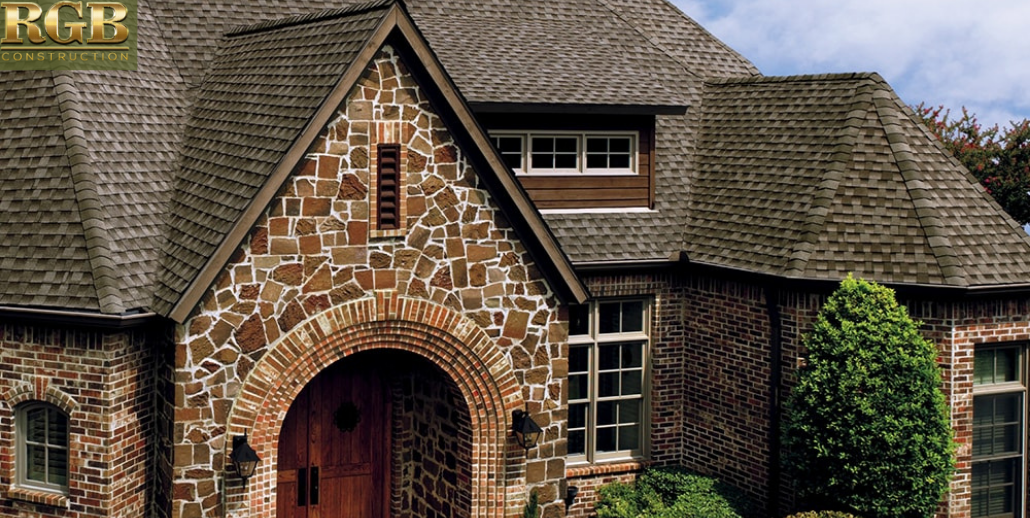When it comes to roofing materials, homeowners in Gloucester County, New Jersey, have a wide range of options to choose from. Two popular choices are architectural shingles and 3-tab shingles. Each type has its own advantages and considerations. In this article, we will compare architectural shingles and 3-tab shingles, highlighting their pros and cons. Whether you’re building a new home or replacing an existing roof, understanding the differences between these shingle types will help you make an informed decision. Let’s dive in!
Thinking about repairing or replacing a roof can be confusing, particularly when it comes to deciding what kinds of materials to use in the process. Most homeowners want to know the choices available to them. Shingles will likely be part of that choice and, believe it or not, there are innumerable options with shingles. There are colors, shapes, and overall installation techniques that most people are not aware of, so most homeowners should get a basic idea of the different types of shingles before they dive into the roofing process.
Roofing companies in New Jersey offer a variety of roofing materials, but architectural shingles and 3-tab shingles are among the most commonly used. Both options have their unique characteristics, including appearance, durability, and cost. Understanding the pros and cons of each type will help you determine which shingle is the best fit for your home.
What are Architectural Shingles?
Architectural shingles, also known as dimensional or laminate shingles, are a premium roofing material that provides a more textured and layered look compared to 3-tab shingles. These shingles are made of multiple layers of asphalt and are designed to mimic the appearance of natural materials like wood or slate. Architectural shingles are known for their durability and resistance to harsh weather conditions.
What are 3-Tab Shingles?
3-tab shingles are the traditional and more budget-friendly option for roofing. They consist of a single layer of asphalt and are characterized by their flat, uniform appearance. 3-tab shingles are lighter in weight and less expensive than architectural shingles, making them a popular choice for homeowners on a tighter budget.
Categories
Shingles are basically categorized as architectural shingles and 3-tab shingles. They are different and they both have good and bad points. Here is a rundown on both of them:
Architectural Shingles
Architectural shingles have different names. They can be called laminate shingles or dimensional shingles. In contrast to more traditional 3-tab regular shingles, architectural shingles are available in varying sizes and shapes. They also have an appearance that suggests proportion, volume, depth, and dimension. They look like a piece of tile or a shake that has substance to it. With an architectural shingle, you can derive the features of an asphalt shingled roof plus acquire added dimension.
Pros and Cons of Architectural Shingles
Pros:
- Enhanced Aesthetics: Architectural shingles offer a more dimensional and visually appealing look to your home. They can add depth and texture to the roof, enhancing its curb appeal.
- Greater Durability: The multiple layers of asphalt make architectural shingles more durable and resistant to wind, impact, and extreme weather conditions. They have a longer lifespan compared to 3-tab shingles.
- Improved Warranty: Architectural shingles often come with longer warranties, providing homeowners with added peace of mind and protection for their investment.
Cons:
- Higher Cost: Architectural shingles are generally more expensive than 3-tab shingles due to their enhanced appearance and durability. The initial cost of installation may be higher.
- Heavier Weight: The added layers make architectural shingles heavier than 3-tab shingles. This may require additional structural support during installation.
3-tab Shingles
This type of shingle is what is associated with traditional asphalt shingles that are commonly used in roofing projects. They are a single tab and are non-dimensional in shape. They are placed flat to a roof’s decking and do bring a clean and neat appearance to a roofline. They are available in a number of different colors.
Pros and Cons of 3-Tab Shingles
Pros:
- Cost-Effective: 3-tab shingles are more budget-friendly compared to architectural shingles. They offer an economical roofing option for homeowners looking for affordability.
- Lighter Weight: 3-tab shingles are lighter and easier to install, requiring less structural support. This can result in faster installation and potentially lower labor costs.
Cons:
- Limited Aesthetics: 3-tab shingles have a flat and uniform appearance, lacking the depth and texture of architectural shingles. They may not provide the same visual appeal.
- Lesser Durability: 3-tab shingles have a shorter lifespan and are generally less resistant to strong winds and severe weather conditions compared to architectural shingles.
Composition of Architectural and 3-Tab Shingles
Both architectural and 3-tab shingles are composed of asphalt as well as fiberglass with a mat type backing, a top layer of granules and adhesives for adherence. The differences between the two have to do with the overall quality and material input. Architectural shingles contain a higher caliber of asphalt in contrast to 3-tab shingles. They also contain an increased number of granules on their surface, plus stronger adhesives and a base that is thicker and tougher. Architectural shingles are also infused with color distinctions that greatly intensify the look of the shingles. Added surface granules increase the chances of preserving this type of shingle for a longer period of time.
In contrast, 3-tab shingles are very flat in appearance, which is due to the fact that the tabs are of the same size and shape and are evenly placed in rows. As with architectural shingles, 3-tabs are available in colors though the colors are less intense in their coloration and texture.
Consistency of Architectural and 3-Tab Shingles
Consistency or thickness with architectural shingles is another factor that differentiates architectural shingles from 3-tab shingles. They are quite a bit heavier and thicker than 3-tabs. A thicker shingle allows for greater endurance and strength and when it comes to wind and other extreme weather conditions, architectural shingles are considerably more durable. Three-tab shingles are weaker, less durable, and not as long-lasting. They can be subject to damage in areas or regions of the country that experience reoccurring bad weather.
Pros and Cons of Architectural and 3-Tab Shingles
Architectural Pros:
- A more popular choice of roofing material
- Thirty-year guarantee
- Resistance to increased wind speeds
- Increased value to a home
Architectural Cons:
- More costly
- Heavier than traditional asphalt shingles which may make them unsuitable for certain structures.
3-Tab Pros:
- Lighter and consist of less material
- Less expensive
- Used throughout most residential communities because of affordability
3-tab Cons:
- Less thick and often require replacement sooner than expected
- Flat in appearance rather than dimensional
- Not quite as popular in use
Frequently Asked Questions (FAQs)
1. Are architectural shingles worth the extra cost?
Yes, architectural shingles are worth the extra cost for homeowners who value enhanced aesthetics, greater durability, and longer-lasting roofing materials. They provide a premium look and can increase the value of your home.
2. Can I install architectural shingles over existing 3-tab shingles?
In some cases, architectural shingles can be installed over existing 3-tab shingles. However, it’s important to consult with a professional roofing contractor to assess the condition of the existing roof and ensure it can support the additional weight.
3. How long do architectural shingles last?
Architectural shingles can last anywhere from 25 to 50 years, depending on the specific brand, quality, and maintenance. Regular inspections and proper maintenance can prolong their lifespan.
4. Do 3-tab shingles come with warranties?
Yes, most 3-tab shingles come with warranties ranging from 20 to 30 years, although the duration may vary depending on the manufacturer and specific product.
5. Can I switch from 3-tab shingles to architectural shingles?
Yes, it is possible to switch from 3-tab shingles to architectural shingles during a roof replacement. However, it is recommended to consult with a professional roofing contractor to ensure the structural integrity of the roof and to assess any additional requirements for the new shingle type.
Conclusion
When considering roofing options in Gloucester County, New Jersey, it’s essential to weigh the pros and cons of architectural shingles and 3-tab shingles. Both types offer unique benefits and considerations. Architectural shingles provide enhanced aesthetics and durability but come at a higher cost. On the other hand, 3-tab shingles offer cost-effectiveness but have a simpler appearance and shorter lifespan. Consult with a reputable roofing company like RGB Construction to determine the best shingle type for your specific needs and budget.








